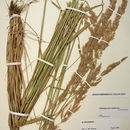Brief Summary
provided by EOL authors
Calamagrostis nutkaensis is distributed in the far western part of North America from Alaska to California, with particular abundance in coastal areas. It is found on certain backshores, coastal prairies, stabilized sand dunes, riparian zones and coastal drainages.
With a common name of Pacific reedgrass, this plant can achieve a height of 150 centimeters; its growth is expressed in basal leaves that merge into dense associations in the wettest areas.
Comprehensive Description
provided by North American Flora
Calamagrostis nutkaensis (Presl) Steud. Syn. Gram. 190. 1854
Deyeuxia nutkaensis Presl. Rel. Haenk. 1: 250. 1830.
Calamagrostis aleutica Trin.; Bong. Mem. Acad. St.-Petersb. VI. 2: 171. 1832. (Type from
Unalaska Island, Alaska.) Deyeuxia aleutica Munro; Hook. f. Trans. Linn. Soc. 23: 345. 1861. (Based on Calamagrostis
aleutica Trin.) Calamagrostis albicans Buckl. Proc. Acad. Phila. 1862: 92. 1862. (Type from Columbia Plains,
Oregon, Nutlall.) Deyeuxia breviaristala Vasey, Bull. Torrey Club 15: 48. 1888. (Type from Vancouver Island,
Macoun in 1887.) Calamagrostis aleutica patens Kearney, Bull. U. S. Dep. Agr. Agrost. 11: 20. 1898. (Type from
Mendocino County, California.)
Culms stout, erect, glabrous or often scabrous, especially below the nodes, 1-1.5 m. tall, with short rhizomes; sheaths glabrous or roughish; ligule 6-S mm. long; blades elongate, flat becoming involute, gradually narrowed to a long point, scabrous, 8-12 mm. wide; panicle usually purplish, narrow, rather loose, 15-30 cm. long, the axis scabrous, the branches rather stiffly ascending, overlapping, the longer ones 3-6 cm. long, or rarely as much as 15 cm. long; glumes acuminate, scaberulous, 5-7 mm. long; lemma indistinctly nerved, about 4 mm. long, the awn rather stout, from near the base, slightly geniculate, about equaling the lemma or shorter; hairs of callus and rachilla about half as long.
Type locality: Nootka Sound, Vancouver Island (Haenke).
Distribution: Moist soil or wet wooded hills along the coast from Aleutian Islands, Alaska, to central California; also Kamchatka.
- bibliographic citation
- Albert Spear Hitchcock. 1937. (POALES); POACEAE (pars). North American flora. vol 17(7). New York Botanical Garden, New York, NY
Physical Description
provided by USDA PLANTS text
Perennials, Aquatic, leaves emergent, Terrestrial, not aquatic, Rhizomes present, Rhizome short and compact, stems close, Stems nodes swollen or brittle, Stems erect o r ascending, Stems caespitose, tufted, or clustered, Stems terete, round in cross section, or polygonal, Stem internodes hollow, Stems with inflorescence less than 1 m tall, Stems with inflorescence 1-2 m tall, Stems, culms, or scapes exceeding basal leaves, Leaves mostly cauline, Leaves conspicuously 2-ranked, distichous, Leaves sheathing at base, Leaf sheath mostly open, or loose, Leaf sheath smooth, glabrous, Leaf sheath and blade differentiated, Leaf blades linear, Leaf blades 2-10 mm wide, Leaf blades 1-2 cm wide, Leaf blades mostly flat, Leaf blade margins folded, involute, or conduplicate, Leaf blades mostly glabrous, Leaf blades scabrous, roughened, or wrinkled, Ligule present, Ligule an unfringed eciliate membrane, Inflorescence terminal, Inflorescence an open panicle, openly paniculate, branches spreading, Inflorescence solitary, with 1 spike, fascicle, glomerule, head, or cluster per stem or culm, Inflorescence branches more than 10 to numerous, Flowers bisexual, Spikelets pedicellate, Spikelets laterally compressed, Spikelet less than 3 mm wide, Spikelets with 1 fertile floret, Spikelets solitary at rachis nodes, Spikelets all alike and fertille, Spikelets bisexual, Spikelets disarticulating above the glumes, glumes persistent, Spikelets disarticulating beneath or between the florets, Rachilla or pedicel hairy, Glumes present, empty bracts, Glumes 2 clearly present, Glumes equal or subequal, Glumes equal to or longer than adjacent lemma, Glume equal to or longer than spikelet, Glumes 1 nerved, Glumes 3 nerved, Lemmas thin, chartaceous, hyaline, cartilaginous, or membranous, Lemma similar in texture to glumes, Lemma 5-7 nerved, Lemma glabrous, Lemma apex dentate, 3-5 fid, Lemma mucronate, very shortly beaked or awned, less than 1-2 mm, Lemma distinctly awned, more than 2-3 mm, Lemma with 1 awn, Lemma awn less than 1 cm long, Lemma awn subapical or dorsal, Lemma awns straight or curved to base, Lemma awn once geniculate, bent once, L emma margins thin, lying flat, Lemma straight, Callus or base of lemma evidently hairy, Callus hairs shorter than lemma, Palea present, well developed, Palea membranous, hyaline, Palea shorter than lemma, Palea about equal to lemma, Palea 2 nerved or 2 keeled, Stamens 3, Styles 2-fid, deeply 2-branched, Stigmas 2, Fruit - caryopsis, Caryopsis ellipsoid, longitudinally grooved, hilum long-linear.
Calamagrostis nutkaensis: Brief Summary
provided by wikipedia EN
Calamagrostis nutkaensis is a species of grass known by the common names Pacific reedgrass and Nootka reedgrass.
It is native to western North America from Alaska to central California, where it is mainly a coastal species growing in moist areas such as beaches and wetlands. This is a perennial bunchgrass forming thick tufts of stems which may exceed a meter in height. There are several flat grass leaves up to a centimeter wide. The inflorescence is usually narrow and thin.
Coastal roadsides in Mendocino County, California can have populations, often receiving fog drip under Eucalyptus stands.
- license
- cc-by-sa-3.0
- copyright
- Wikipedia authors and editors

